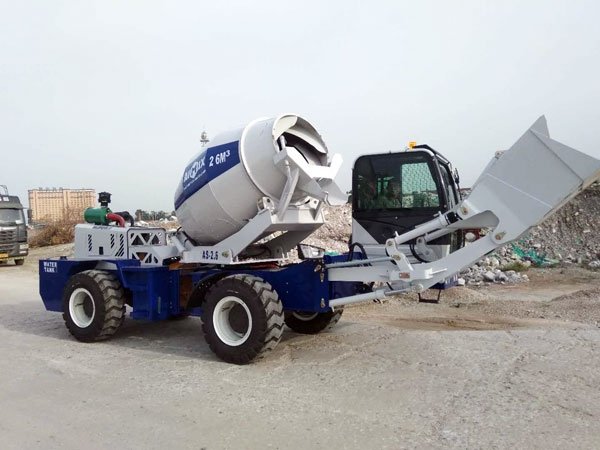A self-loading concrete mixer offers efficiency and convenience on construction sites. Knowing its hourly production capacity helps in planning and optimizing project timelines. This article dives into the factors that determine how much concrete a self-loading mixer can produce per hour.
Mixer CapacityThe capacity of the self-loading mixer drum is crucial in determining the hourly output.https://aimixgroup.com/self-loading-concrete-mixers/
Small Capacity MixersSmall capacity mixers usually have drum sizes of 1 to 2 cubic meters. These mixers can produce around 4 to 8 cubic meters of concrete per hour. They are ideal for small projects and tight spaces.
Medium Capacity MixersMedium capacity mixers have drum sizes from 2 to 4 cubic meters. They can produce approximately 8 to 16 cubic meters of concrete per hour. These mixers balance capacity and maneuverability, making them suitable for medium-sized projects.
Large Capacity MixersLarge capacity mixers feature drum sizes of more than 4 cubic meters. These mixers can produce over 16 cubic meters of concrete per hour. They are designed for large-scale projects and offer high productivity.
The engine power of a self-loading mixer influences its production capacity.
Low-Power EnginesLow-power engines range from 50 to 80 horsepower. These engines can produce around 4 to 8 cubic meters of concrete per hour. They are more fuel-efficient when operating the self loading mixers but may struggle with heavy loads.
Medium-Power EnginesMedium-power engines range from 80 to 120 horsepower. They can produce about 8 to 16 cubic meters of concrete per hour. These engines offer a balance of performance and fuel efficiency.
High-Power EnginesHigh-power engines exceed 120 horsepower. These engines can produce over 16 cubic meters of concrete per hour. They handle heavy loads and large projects efficiently but consume more fuel.
Mixing TimeThe mixing time directly affects the hourly production capacity.
Short Mixing TimeShort mixing times can increase hourly production. Most mixers can complete a batch in 10 to 15 minutes. This allows for up to 6 batches per hour, enhancing productivity.
Extended Mixing TimeLonger mixing times reduce hourly output. Some projects may require extended mixing for better consistency. This can lower the number of batches produced per hour.
Efficiency of Loading and UnloadingLoading and unloading efficiency impacts the hourly production rate.
Efficient Loading SystemsAutomated loading systems speed up the process. Hydraulic or mechanical arms can load materials quickly, increasing production capacity. Efficient loading can save valuable time.
Quick Unloading MechanismsFast unloading mechanisms enhance productivity. Quick-release systems can empty the drum quickly. This allows for faster turnaround times and more batches per hour.
The skill and experience of the operator also play a role in production capacity.
Experienced OperatorsExperienced operators can maximize the mixer's output. They know how to optimize loading, mixing, and unloading times. Their expertise can lead to higher hourly production rates.
Less Experienced OperatorsLess experienced operators may take longer to complete each batch. This can reduce the hourly production rate. Training and practice can help improve their efficiency.
Environmental FactorsEnvironmental conditions can influence the mixer's performance and production capacity.
Optimal Weather ConditionsOptimum weather conditions allow for maximum productivity. Mild temperatures and dry conditions are ideal. They enable the mixer to operate efficiently and produce more concrete.
Adverse Weather ConditionsAdverse weather can reduce production capacity. Extreme heat, cold, or rain can slow down operations. These conditions may require additional precautions, affecting hourly output.
ConclusionSeveral factors determine how much concrete a self-loading mixer can produce per hour. Drum capacity, engine power, and mixing time are crucial. Efficient loading and unloading mechanisms also play a significant role. Operator skill and environmental conditions further influence production capacity.
Small capacity mixers can produce 4 to 8 cubic meters per hour, while medium capacity mixers produce 8 to 16 cubic meters. Large capacity mixers can produce over 16 cubic meters per hour. Low-power engines offer fuel efficiency but may struggle with heavy loads. Medium-power engines balance performance and efficiency. High-power engines handle large projects but consume more fuel.
Short mixing times and efficient loading and unloading systems enhance productivity. Experienced operators can maximize the mixer's output. Optimal weather conditions allow for maximum productivity, while adverse weather can slow down operations.
Understanding these factors helps in planning and optimizing project timelines. This knowledge ensures efficient use of self-loading concrete mixers, leading to successful project completion.

